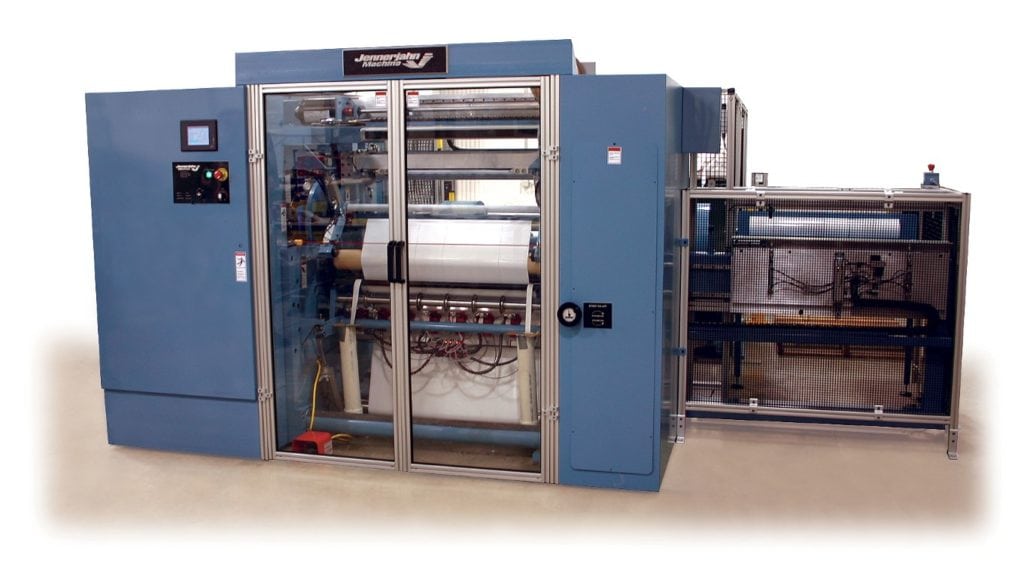Automation is defined as the automatic operation or control of equipment, processes, or systems. Advancements in technology have allowed many standard converting and packaging processes to become automated. These same automated processes are now available for manufacturers of calendered and cast vinyl films.
Valued at 3.2 billion dollars globally in 2020, the vinyl films market is expected to grow by 4.6% over the next 8 years. This forecasted increase is due to the high demand for fleet graphics, outdoor advertising, floor graphics, window graphics, furniture decoration, wall coverings, vehicle wrapping, labels and stickers, motorsports and watercraft graphics, exhibition panels and more.
Companies who convert and package rolls for the graphic vinyl industry integrate automated solutions into their converting and packaging processes to stay competitive while improving productivity and roll quality.
Jennerjahn Two- and Four-Shaft Fully Automatic Center Winders
Jennerjahn Machine, Inc., a U.S.-based manufacturer of fully automated surface slitter rewinders, center winders, and packaging machinery, has responded to the need for automation within the graphic vinyl market. Jennerjahn’s product offering includes both two and four shafted models, the JTS-2 and JTS-4. These fully automatic center winders, by their inherent design, minimize contact between sensitive web surfaces and machinery components.
JTS-2 Shaft Turret Slitter
The JTS-2 loads the cores, seals the tails, and offloads the finished rolls in station 1. The turret rotates 180° to station 2, where slitting and rewinding take place. Typical cycle times for a 150-foot roll of graphic vinyl on the JTS-2 are 60-65 seconds, depending on variables such as heating and cooling the web as well as in-line web inspection.
JTS-4 Shaft Turret Slitter
The JTS-4 is very similar in design and functionality with improved cycle times. The turret system on the JTS-4 rotates 90° between four stations. Cores are loaded in the first station. Slitting and winding take place in the second station. In station 3, the tails are sealed, and in station 4, the finished rolls are offloaded to conveyors for downstream operations. Typical cycle times for a 150-foot roll of graphic vinyl on the JTS-4 are 40–45 seconds, depending on variables such as heating and cooling the web and in-line web inspection.
Roll Widths
The most common master roll widths for the JTS range from 50 to 64 inches, trimmed to 48, 54, and 60 inches. Typical rewind shafts are 2 or 3 inches in diameter with finished roll diameters up to 10 inches. A variety of machine options can be added or customized including driven unwind stands, dual over and under unwind stands, edge guiding, load cell tension control, ovens and chill rollers, inspection and splice stations, splice detection, and static control.
Automating the Vinyl Packaging Process
Commonly, the packaging of vinyl graphic rolls is almost entirely done manually. Labeling, sleeving, core plugging, constructing boxes and loading them, and transferring those boxes to pallets present converters with an array of challenges. These challenges include ergonomic issues, available workspace, product flow, and throughput. Jennerjahn Machine, Inc. designs and integrates custom automated packaging systems for the graphic vinyl market that perform all of the functions listed above without human intervention.
Contact Jennerjahn Machine
Our intent at Jennerjahn is to use available technologies to improve the efficiency of our customers, help them advance their competitive edge in the graphic vinyl market, improve their success, and increase their profitability. Contact Jennerjahn Machine online or call 765-998-2733 to request a proposal tailored to your specific requirements.

